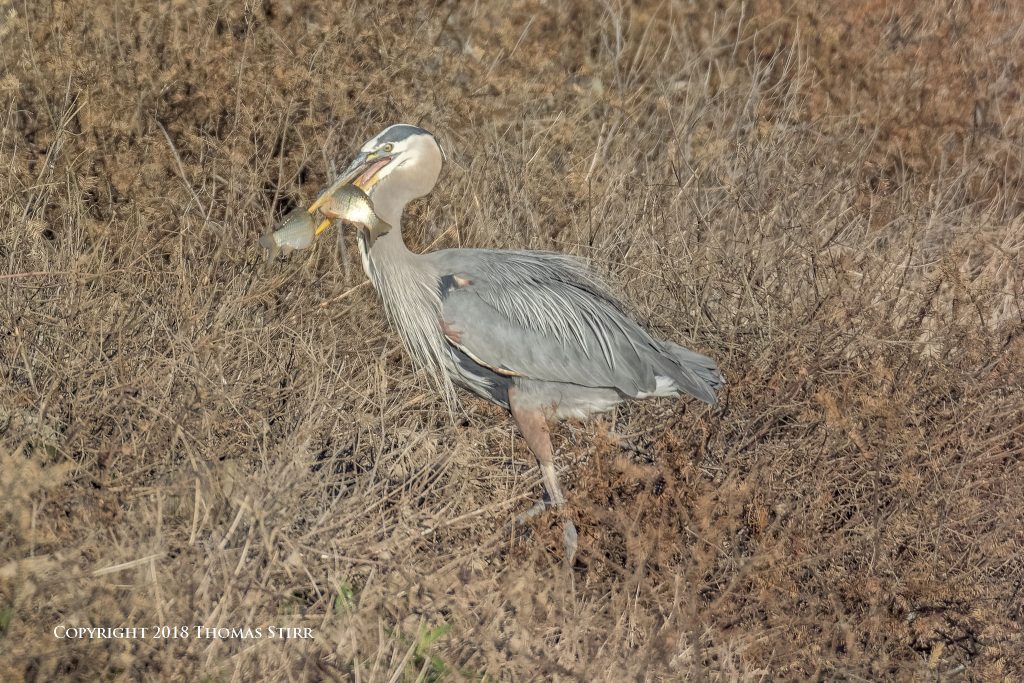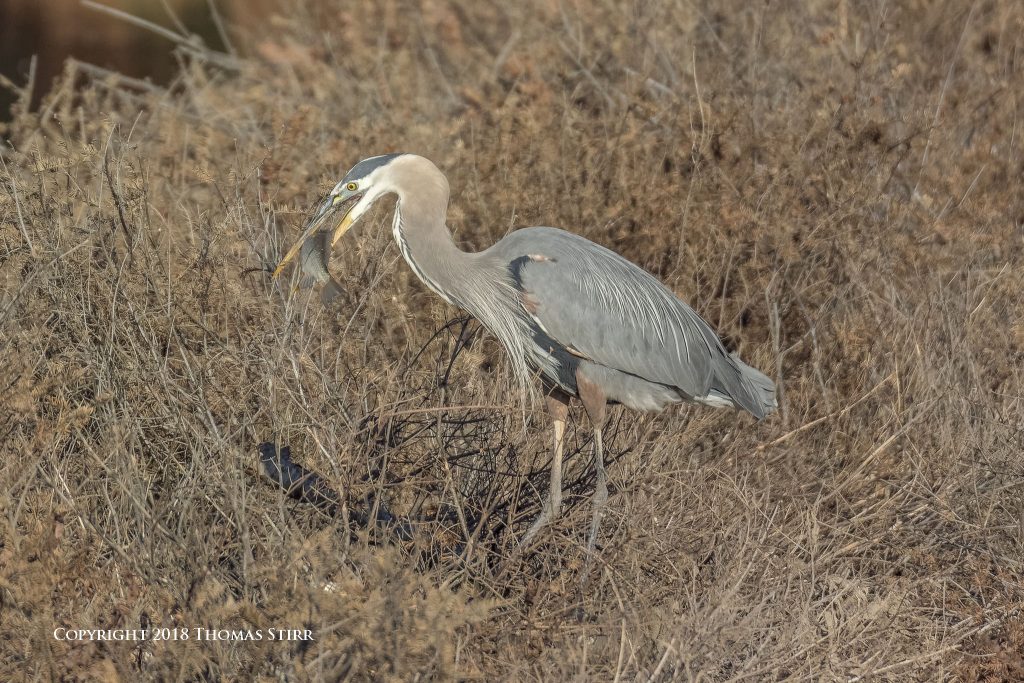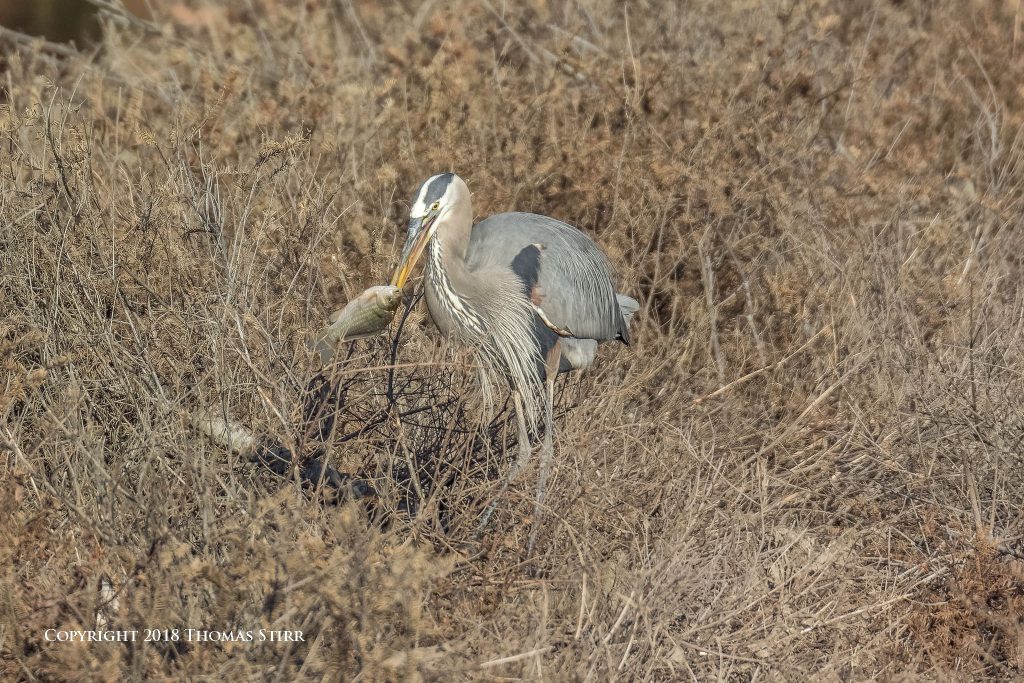Many photographers, when talking about how they got hooked on bird photography, will mention the thrill of capturing some unique moments. It could be a bird-in-flight, birds fighting, a parent bird feeding an offspring, an unusual posture, special lighting, or a bird hunting. This article features a selection of images of a heron catching two fish simultaneously.
NOTE: Click on images to enlarge.

I noticed a Great Blue Heron hunting on one of the berms at the Hendrie Valley Sanctuary. These are man-made structures formed with old pine trees. They are designed to keep carp in Lake Ontario from invading the ponds and stream at the sanctuary. Water can flow through the berms allowing smaller fish and other wildlife to pass through but the berms restrict the movement of large fish like carp. Heron will often perch at the edge of a berm to fish, or will sometimes hunt on the berm itself. They often look for small snakes, rodents, or fish that they can see in the water underneath the berm.

As I watched the heron it made a quick strike into the berm and its head surfaced with two large fish in its beak as you can see in the photograph above.

As the heron struggled with the two large fish in its beak it changed its position. Luckily it turned towards me, facing into the sun, which gave me a great view of its catch. You can see that the heron has one fish impaled on the end of its beak, and the other fish clamped between its upper and lower mandibles.

The heron lowered its head slightly which allowed the clamped fish to slide down its beak towards the impaled fish. Eventually the heron was able to use the weight of the clamped fish to dislodge the impaled fish.

Once the impaled fish dropped off its beak the heron was able to adjust the position of the clamped fish so it could swallow it head first.

After swallowing the original clamped fish, the heron searched through the berm looking for the impaled fish.

Within a few moments the heron found the original impaled fish and its head emerged from the brush with it in its beak. The bird then proceeded to re-position the fish in its beak, then swallow it as you’ll see in the four images that follow.




After the heron swallowed the second fish it waited around a bit, perching on one of the posts along the berm.

It paused for a quick drink…

Then launched itself into flight – giving me other image opportunities.

Anticipating that the heron would soon fly off, I adjusted the focal length of my lens to allow for the wing movements of the bird.
It took less than 14 minutes from the time that I captured the first image of this heron hunting on the berm, until it took off from the post. Those few minutes made the hours I spent at the Hendrie Valley Sanctuary that morning all worthwhile…and are the reason I’ll keep going back.
Technical Note:
All photographs were captured hand-held using Nikon 1 gear as noted in the EXIF data. Images were produced from RAW files using my standard process of DxO PhotoLab, CS6, and the Nik Collection.
Word of mouth is the best form of advertising. If you like our website please let your friends and associates know about our work. Linking to this site or to specific articles is allowed with proper acknowledgement. Reproducing articles or any of the images contained in them on another website is a Copyright infringement.
My intent is to keep this photography blog advertising free. If you enjoyed this article and/or my website and would like to support my work you can purchase an eBook, or make a modest $10 donation through PayPal, both are most appreciated. You can use the Donate button below. Larger donations can be made to tom@tomstirr.com through PayPal.
Article and all images are Copyright 2018 Thomas Stirr. All rights reserved. No use, duplication or adaptation of any kind is allowed without written consent. If you see this article reproduced anywhere else it is an unauthorized and illegal use. Posting comments on offending web sites and calling out individuals who steal intellectual property is always appreciated!


Hi Tom,
Loved the 3rd to sixth images and the last one is a keeper. The details are gorgeous, especially with the grey feathers against the brown shrubbery. Was imagining I could do something similar with a J5 (nearly got one as it’s on sale here but sadly, no more lenses available, especially the 70-300 f/4.5-5.6 CX lens). Keep ’em gorgeous images coming!
Oggie
Thanks for the supportive comment Oggie – I’m glad you enjoyed the images! If I had a tripod with me or a monopod I could have likely taken at least some of the images with a J5 since the heron was reasonably static. It is very difficult to find a 1 Nikon CX 70-300 mm anywhere these days…even a used one. Folks that have them seem to love them and unless they are moving out of the Nikon 1 system tend not to sell those lenses. I was thrilled when I found a Nikon-certified refurbished CX 70-300 to add to my kit.
I’ve been spending a lot of time over the past month or so doing fieldwork for a planned eBook on bird photography and I must say I’ve been having a blast doing it! I’ve got a few more articles planned that you’ll be seeing over the next number of weeks.
Tom
Great captures Tom, for you and the Heron! It is moments like these when we photograph something unique that makes our photographical pursuits so magical.
Hi Ray,
I agree that it is these types of moments that bring magic into our lives – and our images allow us to save that magic as memories
Tom